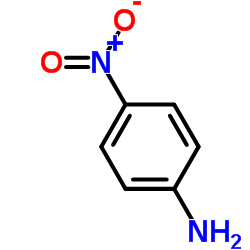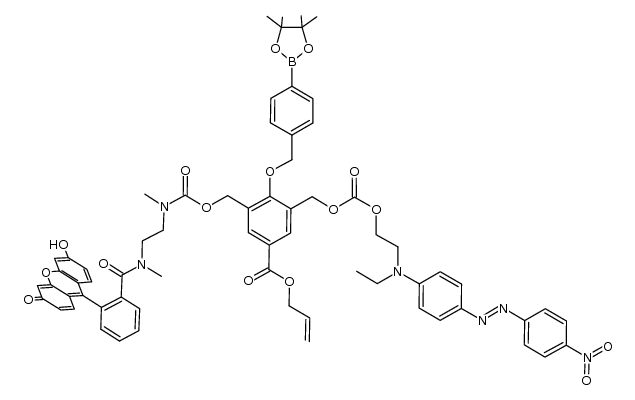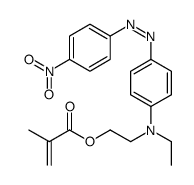Disperse Red 1

Disperse Red 1 structure
|
Common Name | Disperse Red 1 | ||
|---|---|---|---|---|
| CAS Number | 2872-52-8 | Molecular Weight | 314.33900 | |
| Density | 1.23 g/cm3 | Boiling Point | 522.5ºC at 760 mmHg | |
| Molecular Formula | C16H18N4O3 | Melting Point | 160-162 °C(lit.) | |
| MSDS | Chinese USA | Flash Point | 269.8ºC | |
| Symbol |

GHS07 |
Signal Word | Warning | |
Use of Disperse Red 1Disperse Red 1, an azobenzene derivative, is an azo textile dye extensively used for dyeing polyester fabrics in textile industry[1][2]. |
| Name | Disperse Red 1 |
|---|---|
| Synonym | More Synonyms |
| Description | Disperse Red 1, an azobenzene derivative, is an azo textile dye extensively used for dyeing polyester fabrics in textile industry[1][2]. |
|---|---|
| Related Catalog | |
| In Vitro | Exposure of human lymphocytes and a human hepatoma (HepG2) cell line to Disperse Red 1 in vitro at concentrations of 1.0 μg/mL and 2.0 μg/mL increases the frequency of micronuclei and also causes mutations in the Salmonella assay (13 revertants/μg)[2]. |
| In Vivo | To assess the toxic effects of Disperse Red 1 (DR1), on reproduction, sexually mature male mice (Mus musculus, strain CF-1) are orally (gavage) treated with single doses of the compound (20-500 mg/kg). Disperse Red 1 treatment causes testicular toxicity, increases frequency of sperm with abnormal morphology and decreases fertility. An increased amount of DNA damage is also detected in testis cells 16.6 and 24.9 days after treatments with 100 and 500 mg/kg[2]. |
| References |
| Density | 1.23 g/cm3 |
|---|---|
| Boiling Point | 522.5ºC at 760 mmHg |
| Melting Point | 160-162 °C(lit.) |
| Molecular Formula | C16H18N4O3 |
| Molecular Weight | 314.33900 |
| Flash Point | 269.8ºC |
| Exact Mass | 314.13800 |
| PSA | 94.01000 |
| LogP | 4.35200 |
| Vapour Pressure | 9.57E-12mmHg at 25°C |
| Index of Refraction | 1.602 |
CHEMICAL IDENTIFICATION
HEALTH HAZARD DATAACUTE TOXICITY DATA
|
| Symbol |

GHS07 |
|---|---|
| Signal Word | Warning |
| Hazard Statements | H317 |
| Precautionary Statements | P280 |
| Personal Protective Equipment | dust mask type N95 (US);Eyeshields;Faceshields;Gloves |
| Hazard Codes | Xi:Irritant; |
| Risk Phrases | R43 |
| Safety Phrases | S36/37 |
| RIDADR | NONH for all modes of transport |
| WGK Germany | 3 |
| RTECS | KL0320000 |
| HS Code | 3204110000 |
|
~87% 
Disperse Red 1 CAS#:2872-52-8 |
| Literature: Hosseini, S. Hossein; Sarrafi; Hosseini Synthesis and Reactivity in Inorganic, Metal-Organic and Nano-Metal Chemistry, 2013 , vol. 43, # 7 p. 838 - 846 |
|
~% 
Disperse Red 1 CAS#:2872-52-8 |
| Literature: Redy, Orit; Kisin-Finfer, Einat; Sella, Eran; Shabat, Doron Organic and Biomolecular Chemistry, 2012 , vol. 10, # 4 p. 710 - 715 |
|
~% 
Disperse Red 1 CAS#:2872-52-8 |
| Literature: Redy, Orit; Kisin-Finfer, Einat; Sella, Eran; Shabat, Doron Organic and Biomolecular Chemistry, 2012 , vol. 10, # 4 p. 710 - 715 |
|
~% 
Disperse Red 1 CAS#:2872-52-8 |
| Literature: Kuroki; Konishi Bl.Univ.Osaka Prefect., 1956 , vol. 4, p. 123,128 Full Text Show Details Wahl et al. Bulletin de la Societe Chimique de France, 1952 , p. 366,368 Full Text Show Details Kuroki; Konishi Kogyo Kagaku Zasshi, 1956 , vol. 59, p. 619,622,623 Bl.Univ.Osaka Prefect.Chem.Abstr., 1956 , vol. 4, p. 123,128 Bl.Univ.Osaka Prefect.Chem.Abstr., 1958 , p. 4987 |
| HS Code | 2927000090 |
|---|---|
| Summary | 2927000090 other diazo-, azo- or azoxy-compounds。Supervision conditions:None。VAT:17.0%。Tax rebate rate:9.0%。MFN tariff:6.5%。General tariff:30.0% |
|
Assessment of the sensitizing potential of textile disperse dyes and some of their metabolites by the loose-fit coculture-based sensitization assay (LCSA).
Arch. Toxicol. 86(5) , 733-40, (2012) Certain textile disperse dyes are known to cause allergic reactions of the human skin. Here, we examined 8 disperse dyes and 7 products of azo-cleavage of these dyes in an in vitro assay. We used the ... |
|
|
Chlorination treatment of aqueous samples reduces, but does not eliminate, the mutagenic effect of the azo dyes Disperse Red 1, Disperse Red 13 and Disperse Orange 1
Mutat. Res. 703(2) , 200-8, (2010) The treatment of textile effluents by the conventional method based on activated sludge followed by a chlorination step is not usually an effective method to remove azo dyes, and can generate products... |
|
|
Hepatotoxicity assessment of the azo dyes disperse orange 1 (DO1), disperse red 1 (DR1) and disperse red 13 (DR13) in HEPG2 cells.
J. Toxicol. Environ. Health A 75(16-17) , 991-9, (2012) During the dyeing process in baths approximately 10 to 15% of the dyes used are lost and reach industrial effluents, thus polluting the environment. Studies showed that some classes of dyes, mainly az... |
| Amacel Scarlet GB |
| Acetate Fast Scarlet B |
| Dispersol Fast Scarlet B |
| Acetoquinone Light Scarlet BLZ |
| 2-[N-ethyl-4-[(4-nitrophenyl)diazenyl]anilino]ethanol |
| 4-[Ethyl(2-hydroxyethyl)amino]-4'-nitroazobenzene |
| EINECS 220-704-3 |
| Dispersive Ruby Zh |
| Disperse Scarlet Zh |
| N-Ethyl-N-(2-hydroxyethyl)-4-(4-nitrophenylazo)aniline |
| Disperse Red Zh |
| Disperse Scarlet B |
| Acetamine Scarlet B |
| MFCD00007312 |





 CAS#:103553-48-6
CAS#:103553-48-6
